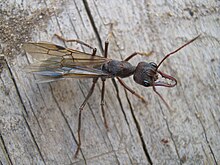Bulldog ants
| Bulldog ants | ||||||||||
|---|---|---|---|---|---|---|---|---|---|---|

|
||||||||||
| Systematics | ||||||||||
|
||||||||||
| Scientific name | ||||||||||
| Myrmeciinae | ||||||||||
| Emery , 1877 |
Bulldog ants (Myrmeciinae) are a subfamily withinthe ants family (Formicidae). Today, bulldogantsare only found in Australia and New Caledonia and are among the most pristine ant species in the world.
features
In ants of the genus Myrmecia , the stalk that connects the trunk ( mesosoma ) and abdomen ( gaster ) is divided into two segments, petiolus and postpetiolus. The mandibles are attached to the outside of the head, very long, more or less straight and with teeth on the inside. With their body length of up to 45 millimeters, they are among the largest and most easily recognizable ants in Australia.
In Nothomyrmecia macrops , the only species of the monotypical genus Nothomyrmecia , the mandibles are elongated and three-sided. They have more than 15 teeth on the inside. The stem has only one segment, which is about the same length as the first segment of the gastric gas. The gaster is smooth and has no constrictions between the segments. At the end of the gaster there is a sting that can be pulled in and so is often difficult to see. The workers of Nothomyrmecia macrops can hardly be confused with other ants in Australia because of their pale yellow color, large eyes, elongated mandibles, lack of postpetiolus and the presence of sting.
distribution
Bulldog ants are most widespread in the southern regions of Australia, where they show the greatest diversity. They are also found in the Australian tropics, but less often. They are often common and found in a number of habitats, including parks and gardens.
Systematics
Within the subfamily Myrmeciinae there are the two tribes Myrmeciini and Prionomyrmecini , each of which contains a genus:
| Myrmeciinae |
|
||||||
|
|
The genus Myrmecia comprises about 90 species, while the genus Nothomyrmecia consists of only one species. Three other species are only known from fossil finds:
- Ameghinoia piatnitzkyi (Viana & Haedo Rossi, 1957)
- Cariridris bipetiolata (Brandao & Martins-Neto, 1990)
- Prionomyrmex longiceps (Mayr, 1868)
However, their exact grouping is uncertain, the latter species is probably assigned to the Prionomyrmecini tribe. The name of the subfamily is derived from the ancient Greek word μυρμήκος ("myrmecos") for ant.
Human and bulldog ants
Bulldog ants are often considered to be aggressive. According to the Guinness Book of Records , the bulldog ant is considered "the most dangerous ant in the world". There have been three fatal human accidents since 1936, the last being reported in 1988. The poison of the bulldog ant is able to cause a strong allergic shock and, under certain circumstances, kill an adult human. In Tasmania , 2.7% of the population were bitten by bulldog ants, according to an epidemiological study. 1% of them showed a life-threatening reaction to the anaphylactic shock.
"Fearless and belligerent, the inch-long bulldog ant of Australia uses her sharp vision and venomous stinger to track and subdue formidable prey."
"Fearless and aggressive, the two and a half centimeter long bulldog ant uses its keen eye and poisonous sting to hunt down and overpower considerable prey."
The immunotoxin from Jack Jumper ants has a toxic effect on malignant cells and, according to Professor Robert Raison, can be used in cancer therapy.
swell
Individual evidence
- ↑ a b Myrmeciinae. CSIRO Ants down under, accessed March 4, 2010 .
- ^ S. Archibald, C. Bruce, Cover, P. Stefan and CS Moreau: Bulldog Ants of the Eocene Okanogan Highlands and the History of the Subfamily (Hymenoptera: Formicidae: Myrmeciinae) . In: Annals of the Entomological Society of America . Volume 99, No. 3 , 2006, p. 487-523 .
- ↑ Alex Wild: Ant Image Gallery (Formicidae). (No longer available online.) Www.myrmecos.net, archived from the original on April 18, 2009 ; accessed on May 26, 2009 . Info: The archive link was inserted automatically and has not yet been checked. Please check the original and archive link according to the instructions and then remove this notice.
- ^ Australian Museum - Bull Ants
- ^ Guinness World Records
- ↑ BBC Documentation: Attack of the Ants
- ↑ Catalyst - Ant Venom ( Memento of the original from December 24, 2013 in the Internet Archive ) Info: The archive link was automatically inserted and not yet checked. Please check the original and archive link according to the instructions and then remove this notice.
- ↑ Allergy.org - Jack Jumper Ant Allergy
- ↑ [1]
- ^ UTS - University of Technology, Sydney
- ^ Romsey Australia, Australian Venomous Ants - Deaths from jumper ant stings have occurred in Australia
literature
- CSIRO , Division of Entomology: Insects of Australia . Melbourne University Press, 1991, ISBN 0-522-84638-6 (English).
- John Clark : The Formicidae of Australia. Vol. 1. Subfamily Myrmeciinae . CSIRO, Melbourne 1951 (English).
Web links
- Subfamily Myrmeciinae - Bulldog Ants and Jumper Ants. Brisbane insects and spiders, January 18, 2009, accessed May 22, 2009 .
